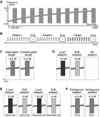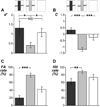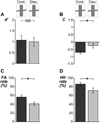Recalibration of the auditory continuity illusion: sensory and decisional effects
- PMID: 21276844
- PMCID: PMC3360525
- DOI: 10.1016/j.heares.2011.01.013
Recalibration of the auditory continuity illusion: sensory and decisional effects
Abstract
An interrupted sound can be perceived as continuous when noise masks the interruption, creating an illusion of continuity. Recent findings have shown that adaptor sounds preceding an ambiguous target sound can influence listeners' rating of target continuity. However, it remains unclear whether these aftereffects on perceived continuity influence sensory processes, decisional processes (i.e., criterion shifts), or both. The present study addressed this question. Results show that the target sound was more likely to be rated as 'continuous' when preceded by adaptors that were perceived as clearly discontinuous than when it was preceded by adaptors that were heard (illusorily or veridically) as continuous. Detection-theory analyses indicated that these contrastive aftereffects reflect a combination of sensory and decisional processes. The contrastive sensory aftereffect persisted even when adaptors and targets were presented to opposite ears, suggesting a neural origin in structures that receive binaural inputs. Finally, physically identical but perceptually ambiguous adaptors that were rated as 'continuous' induced more reports of target continuity than adaptors that were rated as 'discontinuous'. This assimilative aftereffect was purely decisional. These findings confirm that judgments of auditory continuity can be influenced by preceding events, and reveal that these aftereffects have both sensory and decisional components.
Copyright © 2011 Elsevier B.V. All rights reserved.
Figures





Similar articles
-
The continuity illusion adapts to the auditory scene.Hear Res. 2009 Jan;247(1):71-7. doi: 10.1016/j.heares.2008.10.006. Epub 2008 Nov 5. Hear Res. 2009. PMID: 19015017
-
Hearing illusory sounds in noise: sensory-perceptual transformations in primary auditory cortex.J Neurosci. 2007 Nov 14;27(46):12684-9. doi: 10.1523/JNEUROSCI.2713-07.2007. J Neurosci. 2007. PMID: 18003848 Free PMC article.
-
Reduced low-frequency power and phase locking reflect restoration in the auditory continuity illusion.Eur J Neurosci. 2018 Oct;48(8):2849-2856. doi: 10.1111/ejn.13861. Epub 2018 Feb 27. Eur J Neurosci. 2018. PMID: 29430753
-
Functional imaging of auditory scene analysis.Hear Res. 2014 Jan;307:98-110. doi: 10.1016/j.heares.2013.08.003. Epub 2013 Aug 19. Hear Res. 2014. PMID: 23968821 Review.
-
Unveiling the mind's ear: Understanding the science behind auditory processing using illusions.Hear Res. 2025 Apr;459:109227. doi: 10.1016/j.heares.2025.109227. Epub 2025 Feb 25. Hear Res. 2025. PMID: 40020557 Review.
Cited by
-
Hearing an illusory vowel in noise: suppression of auditory cortical activity.J Neurosci. 2012 Jun 6;32(23):8024-34. doi: 10.1523/JNEUROSCI.0440-12.2012. J Neurosci. 2012. PMID: 22674277 Free PMC article.
-
Dynamic cortical representations of perceptual filling-in for missing acoustic rhythm.Sci Rep. 2017 Dec 13;7(1):17536. doi: 10.1038/s41598-017-17063-0. Sci Rep. 2017. PMID: 29235479 Free PMC article.
-
Decoding contextual influences on auditory perception from primary auditory cortex.Elife. 2024 Dec 9;13:RP94296. doi: 10.7554/eLife.94296. Elife. 2024. PMID: 39652382 Free PMC article.
-
Attention, awareness, and the perception of auditory scenes.Front Psychol. 2012 Feb 7;3:15. doi: 10.3389/fpsyg.2012.00015. eCollection 2012. Front Psychol. 2012. PMID: 22347201 Free PMC article.
-
Effect of speech degradation on top-down repair: phonemic restoration with simulations of cochlear implants and combined electric-acoustic stimulation.J Assoc Res Otolaryngol. 2012 Oct;13(5):683-92. doi: 10.1007/s10162-012-0334-3. Epub 2012 May 9. J Assoc Res Otolaryngol. 2012. PMID: 22569838 Free PMC article.
References
-
- Bartlett EL, Wang X. Long-lasting modulation by stimulus context in primate auditory cortex. J Neurophysiol. 2005;94:83–104. - PubMed
-
- Bashford JA, Jr, Warren RM. Multiple phonemic restorations follow the rules for auditory induction. Percept Psychophys. 1987;42:114–121. - PubMed
-
- Benjamini Y, Hochberg Y. Controlling the false discovery rate: a practical and powerful approach to multiple testing. Journal of the Royal Statistical Society. 1995;B57:289–300.
-
- Bennett KB, Parasuraman R, Howard JH, Jr, O'Toole AJ. Auditory induction of discrete tones in signal detection tasks. Percept Psychophys. 1984;35:570–578. - PubMed
Publication types
MeSH terms
Grants and funding
LinkOut - more resources
Full Text Sources
Medical

